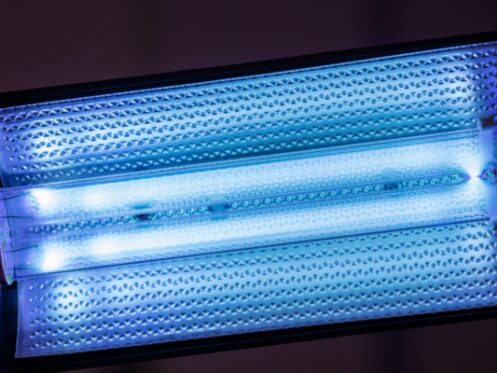Your air quality plays a huge part in your home’s indoor comfort, safety, and energy efficiency. Air that’s full of particulates like dust, dirt, mites, spores, and dander can worsen your allergies and quality of life. You may constantly struggle with sneezing, coughing, watery eyes, fatigue, and trouble concentrating. Large amounts of airborne debris can also wreak havoc on your heating and cooling system and electronics. Fortunately, HVAC ultraviolet (UV) lights are an effective way to neutralize bacteria and germs before they’re circulated in the home. Keep reading to learn more about the benefits and advantages of UV lights.
How They Work
UV lights produce powerful rays of energy that eliminate fungi, bacteria, and germs. These lights were originally used in medical settings to sterilize equipment. For nearly a century, they were installed to treat serious conditions like tuberculosis. They’ve since been adapted for residential use, allowing you to benefit from improved air quality at an affordable expense.
The types of UV rays include UV-A, UV-B, and UV-C. The sun produces a lot of UV-A and UV-B rays, which is why you need to put on sunscreen. UV-C, on the other hand, is a type of ray used in recreational lasers as well as HVAC systems. Of the three UV types, UV-C has the highest amount of energy. This makes it strong enough to kill microscopic bacteria before they can infect your living spaces.
HVAC UV lights are traditionally installed in the ductwork or air handler. While your HVAC filters will be able to catch debris like dust and dander, they’re ineffective against germs and bacteria. These germs will be pulled into the system and eventually make it to the UV light. Once they’re exposed to UV-C, they absorb the rays. UV-C is incredibly successful at targeting bacterial DNA, which ultimately leads to the germ dying or being incapable of reproduction. Pairing your UV light with a high-quality filter gives your home the best protection against bacteria and other contaminants.
UV Light Types
Residential homes have access to either coil sanitizing lights or air sanitizing lights. Both of these lights are compatible with your HVAC system, but they have slightly different purposes and strengths. Air sanitizing lights work better at cleaning your home’s air supply, while coil sanitizing lights focus on cleaning your HVAC system.
Coil Sanitizing
Coil sanitizing lights are the least expensive and typically more popular option. They’re long and thin tube-like lights installed near the air handler. The evaporator coil inside your air handle holds refrigerant, which is a component vital to the cooling process. Due to the constant temperature fluctuations and moisture, this component is highly susceptible to rapid mold and mildew growth.
Too much moisture around this coil can lead to corrosion and a decrease in efficiency. This will impact your home’s comfort as well as your utility costs and the lifespan of your HVAC system. Coil sanitizing lights stay on 24/7 to stop bacteria and mold from forming on or near the coil. Depending on your home or HVAC model, you may have a single or double lamp unit installed.
Coil sanitizing lights are ideal for HVAC system protection. However, they may not be the best option for you if you struggle with severe allergies or respiratory concerns. Optimally, they stop the spread of germs that originate from within your HVAC equipment. These lights can neutralize bacteria pulled into the system, but they’re not as effective as air sanitizing lights.
Air Sanitizing
Air sanitizing lights, which are the more expensive option available, are installed in your ductwork. These are available in both tube and horseshoe shapes. As your return vents suck in air, they send it into your HVAC system where it can be sanitized before being heated or cooled. As these lights are often wired to your blower motor, they’ll turn on and off in sync with your HVAC system.
Air sanitizing lights are more efficient at taking care of indoor air quality issues. They clean the air as it enters your furnace, eliminating any further contamination or germ spread. This is the best option if you or your loved ones have respiratory conditions or other health concerns. While they may cost more to install, they offer greater peace of mind and improved air cleaning.
Benefits of HVAC UV Lights
Since the viruses and germs found in your home are microscopic, you can’t see how UV lights work. Just because their cleaning power isn’t noticeable to the human eye doesn’t mean they won’t have a huge impact on the safety and purity of your living space. In optimum conditions, these energy-efficient lights are at least 99% effective at neutralizing bacteria and germs.
UV lights are able to effectively target the germs and contaminants that worsen health issues like asthma, allergies, and chronic obstructive pulmonary disease. They can even eliminate volatile organic compounds, like tobacco smoke and cooking fumes, that cause unpleasant odors and respiratory distress.
Both types of UV lights stop filth from building up and harming your HVAC system’s fragile components. This premium cleaning ability keeps your furnace and air conditioner running more efficiently for longer. They’ll also lower your need for future maintenance and repairs.
Potential Cons
UV-C rays are a low form of light that’s dangerous to the eyes. Prolonged exposure can cause serious and even permanent eye damage. These rays can also damage your skin and health, leading to redness or more serious diseases in the future. However, in a typical installation, the device is shielded as a precaution, so there’s little to worry about.
It’s essential to rely on a professional to install and service your UV lights. Purchasing your own coil sanitizing lights from the home improvement store puts you at risk of getting a product that isn’t compatible with your HVAC system. You may also not have the right goggles or tools to install it correctly.
Long-term exposure to UV-C can compromise the integrity of certain plastics and other delicate materials inside your HVAC system. Components like the drain pan can develop holes or weaknesses that lead to widespread water damage, rust, and mold. Our HVAC technicians know how to stabilize at-risk parts to ensure they remain effective.
Finally, these lights will need to be regularly cleaned to stop dust buildup. If the light is blocked or obscured, it will be less effective at eliminating bacteria. UV lights also have shorter lifespans than the typical residential light bulb. Light varieties are available in 20, 30 and 40-watt bulbs that last about a year depending on your HVAC use.
Reputable HVAC Company in Riverside
Sheldon's Heating, Air Conditioning & Plumbing is a full-service HVAC company that offers both residential and commercial services in Riverside, CA and surrounding areas. Our team is made up of highly experienced NATE-certified technicians who are adept at delivering true same-day service. All of our trucks are fully stocked and ready to handle common on-the-spot HVAC issues. We’re proud to have been recognized with HomeAdvisor’s Top Rated Award as well as the Carrier President’s Award. Count on us to professionally service or replace your AC, furnace, or heat pump. We can also replace your thermostat, clean your ductwork, and install indoor air quality solutions like air cleaners. Call Sheldon's Heating, Air Conditioning & Plumbing today to learn more about our seasonal HVAC specials and discounts in Riverside.




